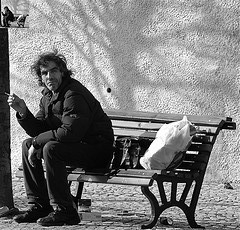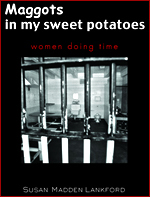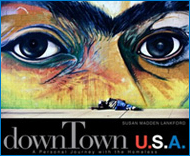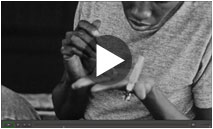 There is a place in the U.S. where prison defines the culture of the area around it. That city is Canon City, Colorado, and it is described on the Prison Valley website as:
There is a place in the U.S. where prison defines the culture of the area around it. That city is Canon City, Colorado, and it is described on the Prison Valley website as:
A town in the middle of nowhere with 36,000 souls and 13 prisons, one of which is Supermax, the new ‘Alcatraz’ of America. A prison town where even those living on the outside live on the inside. A journey into what the future might hold.
The idea boggles the mind. When you start to remember every news item you’ve seen over the decades about prison overcrowding — and realize that each year it’s getting worse — that boggle becomes a chill. Sixteen percent of Canon City’s population are prisoners.
Now you can visit Canon City as easily as you can fire up your web browser. Journalist David Dufresne and photographer Philippe Brault have created an interactive web documentary about the town. Once you start it, you get a narrated drive into the area telling you about the prisons and the settlement that grew up around them. Narrated sequences alternate with interactive experiences to allow you a very organic and in-depth view of the area.
Alison Herd, a writer for Radio France Internationale, comments on the interactive and the social-media-driven aspects of the project:
[…U]sers can check into a room at the motel with a personal Facebook or Twitter account, attend the Dead Warden ceremony run by the Correctional Peace Officers Foundation, visit the prison museum or find out more about the Supermax prison (known as the ‘Alcatraz of the Rockies’).
Above all, the work invites you to go beyond the film, to take part in online debates and exchange emails with people who appear in the documentary.
‘For me, web documentary needs interactivity,’ says photographer Philippe Brault.
‘In Prison Valley we tried to bring debate into the issue of locking people up. That was the ultimate goal: to set off from a small town in Colorado, surrounded by thirteen prisons, soon to be fourteen, and have that story generate debate.’
That is something we applaud. Our own offerings here at HUMANE EXPOSURES are also geared towards expanding the conversation around these topics and exploring possibilities for substantive change. (Just take a look at the items we cover daily on this blog.)
So, please watch Prison Valley. If the awards mean anything, you’re in for quite a ride! Just take a look at what the piece has garnered already in 2010:
Awards:
- Bellaria Film Festival (Italy): “Best Crossmedia program”
- FWA (England): “Site of the day”
- Visa pour l’image RFI/France 24 (Perpignan, France): “Best web documentary”
- Prix Italia (Torino, Italy): “Best interactive site linked to a TV program”
Official Selections:
- Sheffield Doc/Fest (England)
- INPUT (Budapest, Hungary, and Sydney, Australia)
- Rio International Film Festival 2010 (Brazil)
- IDFA DocLab at South By Southwest (Austin, Texas)
It’s a fascinating use of technology and an important study of where the out-of-control penal system could lead if substantive changes are not made. To watch the film, click on this link: Watch Prison Valley Now.
Source: “SOS photojournalism: web docs to the rescue?” Radio France Internationale, 09/1/10
Source: “Prison Valley,” Prison Valley, 2010
Prison Valley Logo, used under Fair Use: Reporting.
Visit Us on Facebook: Humane Exposures Publishing , downTownUSA, Maggots in My Sweet Potatoes, It’s More Expensive To Do Nothing

 We cover a lot of prison issues on this blog. However, up till now, we’ve yet to touch on one of the most infamous prisons in modern American history — Guantanamo.
We cover a lot of prison issues on this blog. However, up till now, we’ve yet to touch on one of the most infamous prisons in modern American history — Guantanamo. Photography is a powerful tool for getting across the humanity behind the major issues of the day. Of course, at HUMAN
Photography is a powerful tool for getting across the humanity behind the major issues of the day. Of course, at HUMAN
 Among the significant number of homeless teens on the street there are many who have been reduced by circumstances to prostitution. It’s a grim and ugly reality.
Among the significant number of homeless teens on the street there are many who have been reduced by circumstances to prostitution. It’s a grim and ugly reality.
 Early morning last Monday had seen faces that you wouldn’t normally see at that hour fan out through downtown San Diego, as the volunteers had attempted to take a census of the society’s disenfranchised. The effort is part of a national initiative to get better data about the homeless population so that help can be given to those most in need. The goal is to reduce the number of homeless on the streets by 100,000 between now and the middle of 2013.
Early morning last Monday had seen faces that you wouldn’t normally see at that hour fan out through downtown San Diego, as the volunteers had attempted to take a census of the society’s disenfranchised. The effort is part of a national initiative to get better data about the homeless population so that help can be given to those most in need. The goal is to reduce the number of homeless on the streets by 100,000 between now and the middle of 2013. There are many paths taken by those on the streets. For an unfortunate number of pople, one of those paths is prostitution, and they get started at an earlier age than some of us would think.
There are many paths taken by those on the streets. For an unfortunate number of pople, one of those paths is prostitution, and they get started at an earlier age than some of us would think.








